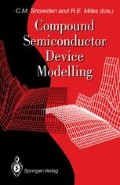Abstract
Transferred-electron devices (utilizing the bulk negative resistance of gallium arsenide, indium phosphide or related compounds) and avalanche devices that use impact ionization in high electric field — are the most powerful solid-state sources of microwave energy. In this Chapter, we discuss different approaches to modeling these devices. First, we consider the mechanism responsible for the negative differential mobility in GaAs. Then we discuss and compare a full blown self-consistent Monte Carlo simulation of transferred electron devices with a much simpler (but a far less accurate) approach based on the drift-diffusion equation. Then we consider IMPATT devices which use phase delays related to avalanche breakdown and carrier drift in a semiconductor diode and discuss additional problems involved in modeling IMPATT devices.
Access this chapter
Tax calculation will be finalised at checkout
Purchases are for personal use only
Preview
Unable to display preview. Download preview PDF.
References
K. Bløtekjaer, Transport Equations for Two-Valley Semiconductors, IEEE Trans. Electron Devices, ED-17, No. 1, pp. 38–47, Jan. (1970)
K. H. Brennan, N. Mansour, and Y. Wang, Simulation of Advanced Semiconductor Devices Using Supercomputers, Computer Physics Communications, vol. 67, No. 1, pp. 173–92 (1991)
M. Curow, Applied Physics Letters, (1992)
M. I. D’yakonov, M. E. Levinshtein, and G. S. Simin, Soviet Phys. Semicond., 13, No. 7, pp. 1365–1368(1981)
R. S. Engelbrecht, Bulk Effect Devices for Future Transmission Systems, Beff Lab. Rec., 45, No. 6, pp. 192–201 (1967)
B. Gelmont, K.-S. Kim, and M. S. Shur, Theory of Impact Ionization and Auger Recombination in HgCdTe, Phys. Rev. Lett., 69, No. 8, pp. 1280–1283, August (1992)
H. Gummel, A Self-consistent Iterative Scheme for One-dimensional Steady State Transistor Calculations, IEEE Trans. Electron Devices, ED-11, pp. 455–465 (1964)
J. B. Gunn, Microwave Oscillations of current in III–V semiconductors, Solid State Communications, 1 (4), pp. 88–91 (1963)
J. B. Gunn, Electron Transport Properties Relevant to Instabilities in GaAs, J. Phys. Soc. Jap., Supplement, pp. 509–513 (1966)
C. Hilsum, Transferred Electron Amplifiers and Oscillators, Proc. IRE, 50,(2), pp. 185–189 (1962).
C. Jacoboni and P. Lugli, The Monte Carlo Method for Semiconductor Simulation, Springer Series on Computational Microelectronics, ed. S. Selberherr, Springer-Verlag, Wien, New York (1989)
G.U. Jensen, B. Lund, M. Shur, and T.A. Fjeldly, Monte Carlo Simulation of Short Channel Heterostructure Field Effect Transistors, Computer Physics Communications, vol. 67, No. 1, pp. 1–61 (1991)
R. L. Johnston, B. C. DeLoach, Jr., and B. G. Cohen, Bell Syst. Tech. J., 44, p. 369 (1965)
S. H. Jones, G. B. Tait, and M. Shur, Modulated-Impurity-Concentration Transferred-Electron Devices Exhibiting Large Harmonic Frequency Content, Microwave and Optical Technology Letters, vol. 5, No. 8, pp. 354–359, July (1992)
H. Kroemer, Proc. IEEE, 53, No. 9, p. 1246 (1965)
T. Misawa, IEEE Trans. Electron Devices, ED-13, No. 9, p. 137 (1966)
H. J. Prager, K. K. N. Chang, and S. Weisbrod, High Power, High Efficiency Silicon Avalanche Diodes at Ultrahigh Frequencies, Proc. IEEE, 55, p. 586 (1967)
PRIZM manual, Silvaco (1992)
W. T. Read, Bell Syst. Tech. J., 37, p. 401 (1958)
H. D. Rees, Hot Electron Effects at Microwave Frequencies in GaAs, Solid State Comm., 7, No. 2, pp. 267–269 (1969)
B. K. Ridley and T. B. Watkins, The Possibility of Negative Resistance, Proc. Phys. Soc., 78 (8), pp. 293–304 (1961)
D. L. Scharfetter, D. J. Bartelink, H. K. Gummel, and R. L. Johnson, IEEE Trans. Electron Devices, ED-15, p. 691 (1968)
M. Shoji, Functional Bulk Semiconductor Oscillators, IEEE Trans. Electron Devices, ED-14, No. 9, pp. 533–546 (1967)
M. Shur, Influence of Non-Uniform Field Distribution in the Channel on the Frequency Performance of GaAsFETs, Electronics Letters, 12, No. 23, pp. 615–616 (1976)
M. Shur, GaAs Devices and Circuits, Plenum Publishing, New York (1987)
M. Shur, Physics of Semiconductor Devices, Prentice Hall, New Jersey (1990)
G. B. Tait and C. M. Krowne, Efficient Transferred Electron Device Simulation Method for Microwave and Millimeter Wave CAD Applications, Solid-State Electronics, vol. 30, No. 10, pp. 1025–1036 (1987)
G. B. Tait and C. M. Krowne, Large Signal Characterizations of Unipolar III-V Semiconductor Diodes at Microwave and Millimeter-Wave Frequencies, IEEE Trans. Electron Devices, ED-35, No. 2, pp. 223–229 (1988)
A. S. Tager, A. I. Mel’nikov, G. P. Kobel’kov, and A. M. Tsebiev, Discovery Diploma #24, priority date No. 27, 1959 (in Russian), see also A. S. Tager and V. M. Vald-Perlov, Lavinnoproletnye Diody (in Russian ), Soviet Radio (1968)
J. Xu and M. Shur, IEEE Trans. Electron Devices, ED-34, No. 8, pp. 1831–1832 (1987)
Author information
Authors and Affiliations
Editor information
Editors and Affiliations
Rights and permissions
Copyright information
© 1993 Springer-Verlag London Limited
About this chapter
Cite this chapter
Shur, M. (1993). Gunn Diode and IMPATT Diode Modelling. In: Snowden, C.M., Miles, R.E. (eds) Compound Semiconductor Device Modelling. Springer, London. https://doi.org/10.1007/978-1-4471-2048-3_5
Download citation
DOI: https://doi.org/10.1007/978-1-4471-2048-3_5
Publisher Name: Springer, London
Print ISBN: 978-1-4471-2050-6
Online ISBN: 978-1-4471-2048-3
eBook Packages: Springer Book Archive

